英语的四种文体的区别
- 格式:ppt
- 大小:254.00 KB
- 文档页数:5

英文写作文体九种分类同文体的写作书面表达旨在测试学生的英语书面表达能力。
高考的书面表达是一种指导性写作。
试题对写作的目的,对象,体裁及字数等都有明确的规定。
提供给学生的材料形式为文字,图画或图表。
试题要求学生根据所给的情景和要表达的意义,写出一篇 100 字左右的文章。
高考中常见的文体为记叙文、说明文、议论文和应用文等。
(一)记叙文:记叙文是以叙述人物的经历或事物的发展变化过程为主的一种文体。
它分为记人和记事两种。
记叙文的几个要点为: 1. 时间、地点、人物、事件,这几个要素在写作时要交代清楚。
2. 人称:记叙文一般可以有第一人称和第三人称两种叙事方式:第一人称是作者以当事人的口吻,把文章中的事情以“我”的所见所闻的方式来叙述,第三人称是写作者从旁观者的角度来叙述,反映事件中的不同人的感受和见解。
3. 记叙文的线索一般为时间,即按照事件的发展顺序来写。
以可以按照地点的线索来写,即以地点的转移为顺序。
4. 重点突出,层次分明,详略得当。
5. 注意文章的完整性。
6. 所用的时态通常为一般过去时。
例: NMET 2021 辽宁卷下面四幅图片描述的是星期天上午在中山公园里发生的一件事。
请根据图片所提供的信息用英语为你校的“英语园地”写一篇文章。
注意:1. 短文必须包括所有图片的主要内容,短文的内容要连贯,完整。
2. 短文单词数 100左右。
3. 参考词汇:货摊 stand 抢夺 snatch 逮捕 arrest 写作步骤: 1. 审题:理解图意,将几幅图连成一个完整的故事。
2. 列出要点:地点:公园的冰激凌货摊旁。
人物:一名年轻妇女,一个小偷和一个老人。
事件:年轻妇女的包被抢,人们追赶,老人用伞将其绊倒,警察逮捕抢劫者,妇女和人们感谢老人。
3. 将要点扩展成文,注意上下文的连接,用适当的连词,副词。
4. 通读一遍,改错。
Possible Version: One Sunday morning, there were some people in Zhongshan Park. At a stand, a woman was buying an ice cream when a young man behind her snatched her handbag away. She shouted, “Stop the thief! He's snatched mybag!” Hearing this, a few people began to run after him. There was an old man sitting quietly on a bench nearby. As the snatcher was running past him, the old man quickly picked up his umbrella and put it between the snatcher's legs. The young man fell down on the ground hard. Soon two policemen came in a police car and arrested him. The woman thanked the old man, and the people around praised the old man for his cleverness. (二)议论文:在近几年的高考中,议论文的比重占得越来越多,议论文的出题形式可以多种多样,有看图写作、图表、表格、书信等各种类型,但文体实际上是议论文,而有时是夹叙的议论文。
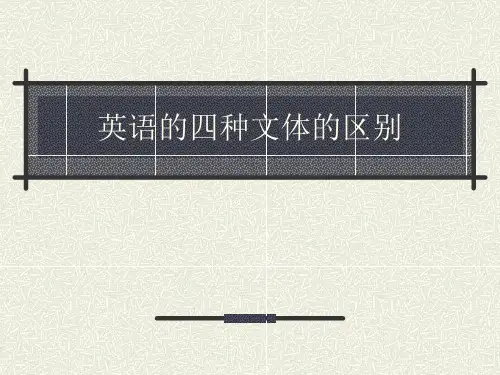
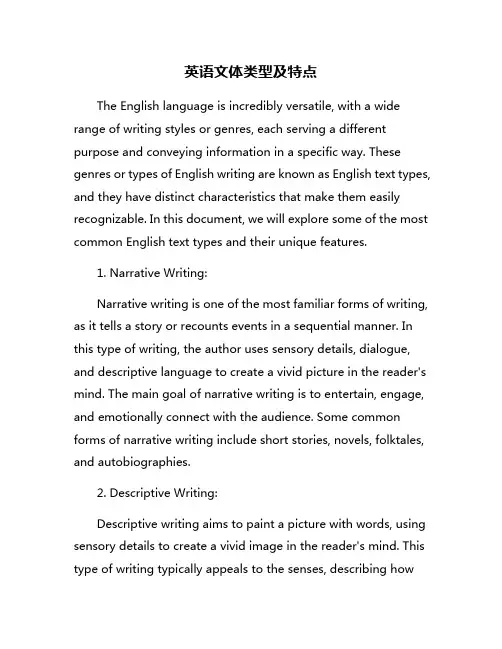
英语文体类型及特点The English language is incredibly versatile, with a wide range of writing styles or genres, each serving a different purpose and conveying information in a specific way. These genres or types of English writing are known as English text types, and they have distinct characteristics that make them easily recognizable. In this document, we will explore some of the most common English text types and their unique features.1. Narrative Writing:Narrative writing is one of the most familiar forms of writing, as it tells a story or recounts events in a sequential manner. In this type of writing, the author uses sensory details, dialogue, and descriptive language to create a vivid picture in the reader's mind. The main goal of narrative writing is to entertain, engage, and emotionally connect with the audience. Some common forms of narrative writing include short stories, novels, folktales, and autobiographies.2. Descriptive Writing:Descriptive writing aims to paint a picture with words, using sensory details to create a vivid image in the reader's mind. This type of writing typically appeals to the senses, describing howsomething looks, feels, sounds, smells, or tastes. Descriptive writing can transport the reader to a specific time or place, evoking emotions and creating a sensory experience. Descriptive writing is often used in poetry, travel writing, and creative nonfiction.3. Expository Writing:Expository writing is informative writing that explains, clarifies, or describes a topic in an objective and factual manner. This type of writing aims to educate the reader on a specific subject, providing clear explanations, evidence, and examples to support the main idea. Expository writing may include textbooks, academic essays, news articles, and research papers. The tone of expository writing is typically formal and straightforward, focusing on presenting well-researched information in a logical order.4. Persuasive Writing:Persuasive writing is designed to convince the reader to adopt a particular viewpoint or take a specific course of action. In this type of writing, the author presents a strong argument supported by evidence, examples, and persuasive language to influence the reader's opinion. Persuasive writing often includes rhetorical devices, emotional appeals, and logical reasoning tosway the reader's beliefs or behavior. Common examples of persuasive writing include advertisements, editorials, speeches, and opinion pieces.5. Argumentative Writing:Argumentative writing is similar to persuasive writing but focuses on presenting two sides of an issue or topic and defending a particular claim with evidence and logical reasoning. In argumentative writing, the author acknowledges counterarguments and refutes opposing viewpoints to strengthen their own argument. This type of writing requires critical thinking skills, research, and analysis to support a thesis statement and persuade the reader to accept a specific position. Argumentative writing is commonly found in academic essays, debates, and opinion articles.6. Reflective Writing:Reflective writing is introspective writing that explores personal thoughts, feelings, and experiences. This type of writing encourages self-reflection, introspection, and insight into one's emotions, beliefs, and values. Reflective writing may involve analyzing past events, discussing personal growth or development, and examining the impact of experiences on one'slife. Reflective writing is often found in journals, diaries, essays, and personal narratives.Each of these English text types has its own unique features and purposes, but they all serve as tools for communication, expression, and creativity. By understanding the characteristics of each text type and how to effectively use them, writers can convey their ideas, emotions, and messages in a clear and engaging manner. Whether writing a story, an argument, a description, or a reflection, mastering these text types can help writers communicate effectively and connect with their audience on a deeper level.。

英文文章的体裁有很多种,以下是一些常见的英文文章体裁:
1.新闻报道:新闻报道是关于近期发生的事件、人物或事物的报道。
它通常包
括标题、导语、正文和结尾,并遵循一定的新闻写作规范。
2.说明文:说明文是一种解释、说明某事物或概念的文章体裁。
它通常包括引
言、正文和结论,正文部分会详细解释说明主题。
3.议论文:议论文是一种阐述作者观点、论证某一观点或主张的文章体裁。
它
通常包括引言、正文和结论,正文部分会通过论据支持论点。
4.记叙文:记叙文是一种叙述事件、人物或情景的文章体裁。
它通常包括引言、
正文和结尾,正文部分会描述事件的起因、经过和结果。
5.散文:散文是一种灵活自由的文学形式,可以包括描写、叙述、抒情、议论
等多种元素。
它通常表达作者的情感、思想或对生活的感悟。
6.小说:小说是一种虚构的文学作品,通过人物的塑造、情节的安排和环境的
描写来反映社会生活。
它通常包括开头、发展和高潮部分。
7.诗歌:诗歌是一种以语言为媒介的文学艺术形式,通过音韵、节奏和意象来
表达情感和思想。
它通常具有独特的韵律和节奏感。
以上是英文文章的一些常见体裁,每种体裁都有其特定的写作规范和特点,需要根据不同的需求和场合选择适当的体裁进行写作。
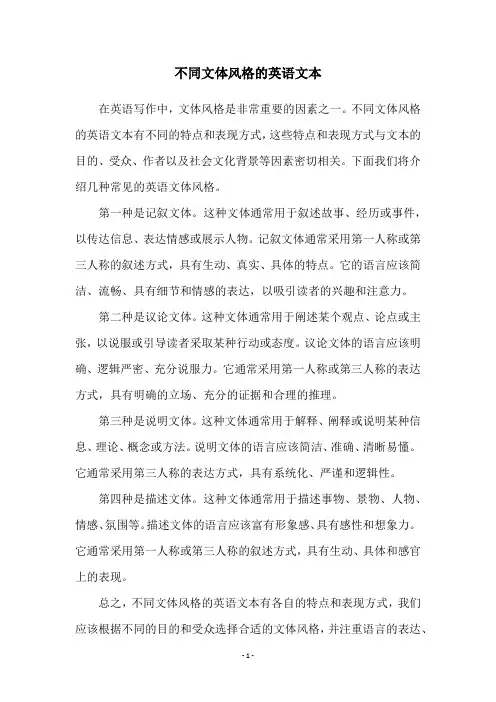
不同文体风格的英语文本
在英语写作中,文体风格是非常重要的因素之一。
不同文体风格的英语文本有不同的特点和表现方式,这些特点和表现方式与文本的目的、受众、作者以及社会文化背景等因素密切相关。
下面我们将介绍几种常见的英语文体风格。
第一种是记叙文体。
这种文体通常用于叙述故事、经历或事件,以传达信息、表达情感或展示人物。
记叙文体通常采用第一人称或第三人称的叙述方式,具有生动、真实、具体的特点。
它的语言应该简洁、流畅、具有细节和情感的表达,以吸引读者的兴趣和注意力。
第二种是议论文体。
这种文体通常用于阐述某个观点、论点或主张,以说服或引导读者采取某种行动或态度。
议论文体的语言应该明确、逻辑严密、充分说服力。
它通常采用第一人称或第三人称的表达方式,具有明确的立场、充分的证据和合理的推理。
第三种是说明文体。
这种文体通常用于解释、阐释或说明某种信息、理论、概念或方法。
说明文体的语言应该简洁、准确、清晰易懂。
它通常采用第三人称的表达方式,具有系统化、严谨和逻辑性。
第四种是描述文体。
这种文体通常用于描述事物、景物、人物、情感、氛围等。
描述文体的语言应该富有形象感、具有感性和想象力。
它通常采用第一人称或第三人称的叙述方式,具有生动、具体和感官上的表现。
总之,不同文体风格的英语文本有各自的特点和表现方式,我们应该根据不同的目的和受众选择合适的文体风格,并注重语言的表达、
逻辑的思考与文化的背景。
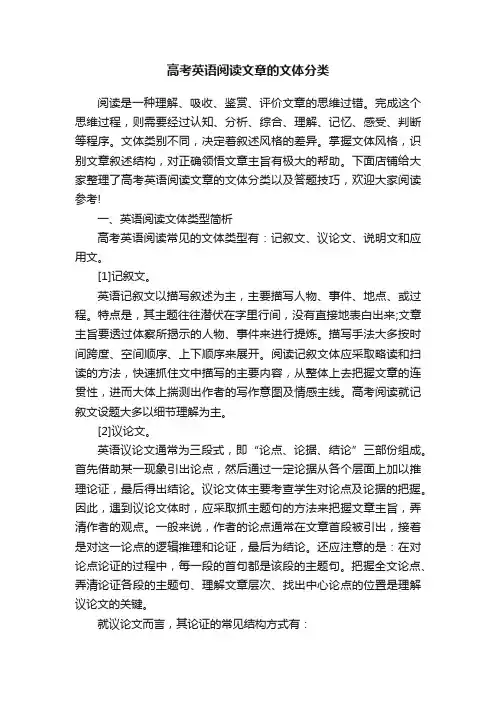
高考英语阅读文章的文体分类阅读是一种理解、吸收、鉴赏、评价文章的思维过错。
完成这个思维过程,则需要经过认知、分析、综合、理解、记忆、感受、判断等程序。
文体类别不同,决定着叙述风格的差异。
掌握文体风格,识别文章叙述结构,对正确领悟文章主旨有极大的帮助。
下面店铺给大家整理了高考英语阅读文章的文体分类以及答题技巧,欢迎大家阅读参考!一、英语阅读文体类型简析高考英语阅读常见的文体类型有:记叙文、议论文、说明文和应用文。
[1]记叙文。
英语记叙文以描写叙述为主,主要描写人物、事件、地点、或过程。
特点是,其主题往往潜伏在字里行间,没有直接地表白出来;文章主旨要透过体察所揭示的人物、事件来进行提炼。
描写手法大多按时间跨度、空间顺序、上下顺序来展开。
阅读记叙文体应采取略读和扫读的方法,快速抓住文中描写的主要内容,从整体上去把握文章的连贯性,进而大体上揣测出作者的写作意图及情感主线。
高考阅读就记叙文设题大多以细节理解为主。
[2]议论文。
英语议论文通常为三段式,即“论点、论据、结论”三部份组成。
首先借助某一现象引出论点,然后通过一定论据从各个层面上加以推理论证,最后得出结论。
议论文体主要考查学生对论点及论据的把握。
因此,遇到议论文体时,应采取抓主题句的方法来把握文章主旨,弄清作者的观点。
一般来说,作者的论点通常在文章首段被引出,接着是对这一论点的逻辑推理和论证,最后为结论。
还应注意的是:在对论点论证的过程中,每一段的首句都是该段的主题句。
把握全文论点、弄清论证各段的主题句、理解文章层次、找出中心论点的位置是理解议论文的关键。
就议论文而言,其论证的常见结构方式有:1,总分式总---分;分----总;总----分---总;2,并列式几个论据之间属于平等关系;3,递进式几个论据之间属于递进关系;4,对照式把两种事物加以对比,以彰显其中一种。
[3]说明文。
英语说明文的总体结构通常为三部份,说明对象、说明过程和归纳总结。
常见的说明方法:1,定义与诠释说明;2,举例与引用说明;3,分类与图表说明;4,比较与比喻说明;5,分析与综合说明;就高考英语说明文的阅读而言,首先要抓住文章说明的要点,也就是要抓住被说明对象的实质性特征;弄清作者从哪个角度、哪个层面开始说明;并明白文章最后的说明结论。
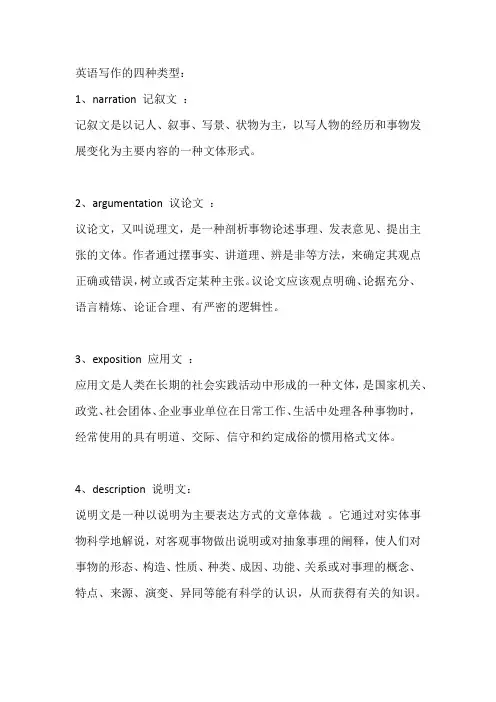
英语写作的四种类型:
1、narration 记叙文:
记叙文是以记人、叙事、写景、状物为主,以写人物的经历和事物发展变化为主要内容的一种文体形式。
2、argumentation 议论文:
议论文,又叫说理文,是一种剖析事物论述事理、发表意见、提出主张的文体。
作者通过摆事实、讲道理、辨是非等方法,来确定其观点正确或错误,树立或否定某种主张。
议论文应该观点明确、论据充分、语言精炼、论证合理、有严密的逻辑性。
3、exposition 应用文:
应用文是人类在长期的社会实践活动中形成的一种文体,是国家机关、政党、社会团体、企业事业单位在日常工作、生活中处理各种事物时,经常使用的具有明道、交际、信守和约定成俗的惯用格式文体。
4、description 说明文:
说明文是一种以说明为主要表达方式的文章体裁。
它通过对实体事物科学地解说,对客观事物做出说明或对抽象事理的阐释,使人们对事物的形态、构造、性质、种类、成因、功能、关系或对事理的概念、特点、来源、演变、异同等能有科学的认识,从而获得有关的知识。

英语四大基本文体
英语中的四大基本文体是记叙文(narrative essay),说明文(expository essay),议论文(argumentative essay)和说明文(descriptive essay)。
记叙文是通过叙述事情的经过、人物的行为和情节的发展来传递信息或表达感受的文体。
它通常由一系列事件或故事组成,包含时间、地点、人物、情节等要素。
说明文是用来解释、阐述或传递信息的文体。
它可以用来描述一个概念、一个过程、一个观点或一个现象。
说明文通常包含事实、数据、例子和逻辑推理等来支持作者的观点或说明信息。
议论文是用来表达观点、辩论和说服读者的文体。
议论文通常包含一个明确的观点(也称为论点)和相关的证据、论证和解释来支持这个观点。
它可以通过逻辑、权威性的引用或对比等方法来增强说服力。
说明文是用来描绘事物的特征、外观和感官体验的文体。
它通过详细和生动的描述来让读者感知事物的各个方面。
说明文可以通过用词的精确选择、比喻、比较等手法来传达作者对事物的感受或呈现细节。
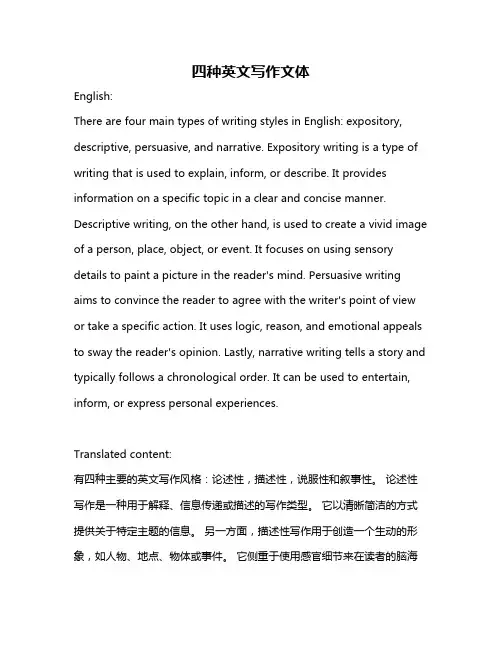
四种英文写作文体English:There are four main types of writing styles in English: expository, descriptive, persuasive, and narrative. Expository writing is a type of writing that is used to explain, inform, or describe. It provides information on a specific topic in a clear and concise manner. Descriptive writing, on the other hand, is used to create a vivid image of a person, place, object, or event. It focuses on using sensory details to paint a picture in the reader's mind. Persuasive writing aims to convince the reader to agree with the writer's point of view or take a specific action. It uses logic, reason, and emotional appeals to sway the reader's opinion. Lastly, narrative writing tells a story and typically follows a chronological order. It can be used to entertain, inform, or express personal experiences.Translated content:有四种主要的英文写作风格:论述性,描述性,说服性和叙事性。
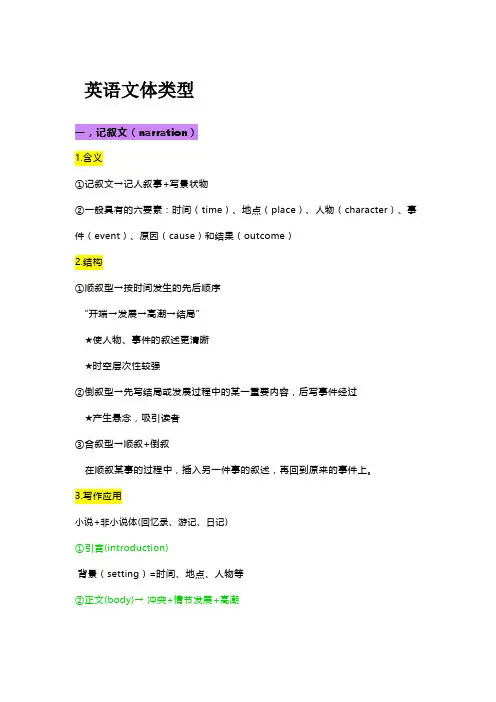
英语文体类型一,记叙文(narration)1.含义①记叙文→记人叙事+写景状物②一般具有的六要素:时间(time)、地点(place)、人物(character)、事件(event)、原因(cause)和结果(outcome)2.结构①顺叙型→按时间发生的先后顺序“开端→发展→高潮→结局”★使人物、事件的叙述更清晰★时空层次性较强②倒叙型→先写结局或发展过程中的某一重要内容,后写事件经过★产生悬念,吸引读者③合叙型→顺叙+倒叙在顺叙某事的过程中,插入另一件事的叙述,再回到原来的事件上。
3.写作应用小说+非小说体(回忆录、游记、日记)①引言(introduction)背景(setting)=时间、地点、人物等②正文(body)→冲突+情节发展+高潮◆冲突→两种不同思想或力量的矛盾、纠葛、撞击或对抗,它不但存在于不同人物、不同性格之间,而且存在于同一个人物的内心世界里。
三种类型的冲突:不同人物之间的冲突,人与环境之间的冲突,个人心灵深处不同思想的冲突◆情节的内容由人物性格的矛盾和冲突构成。
情节常常表现为一系列故事,可以说,凡情节都包含某种故事或故事性。
◆高潮→情节发展到达顶点矛盾双方已剑拔弩张,斗争达到白热化程度。
人物命运即将决定,主题思想得到集中表现。
③结尾(conclusion)故事的结局→矛盾冲突的最后解决、人物命运的最后归宿一个好的结尾往往能提供一个完满的答案,或答案已明确,却留下一些令人深省、回味的东西。
二. 描写文(description)1.含义对客观世界加以艺术和主观的描绘。
它把对某一物体、人物、地方或景色的印象和了解细腻地表达出来,在读者面前再现它们的形象。
2.特点具体性、生动性和创造性描写的细节要能表达主题3.描写顺序空间位置顺序、时间顺序,一般到特殊或特殊到一般顺序,递升到递降或递降到递升顺序4.写作应用①人物描写(description of a person)对人物形象外部特征进行描绘,刻画人物性格特征,表现人物精神面貌,披露人物内心活动,揭示人物身份境遇,显示人物性格变化,突出作品主题思想。
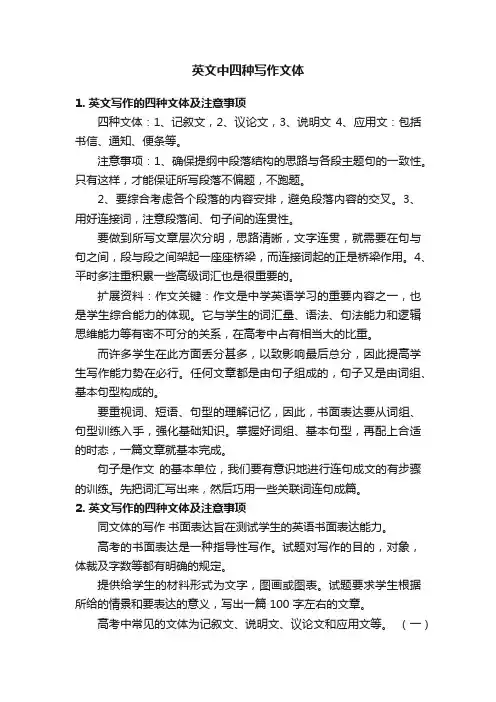
英文中四种写作文体1. 英文写作的四种文体及注意事项四种文体:1、记叙文,2、议论文,3、说明文4、应用文:包括书信、通知、便条等。
注意事项:1、确保提纲中段落结构的思路与各段主题句的一致性。
只有这样,才能保证所写段落不偏题,不跑题。
2、要综合考虑各个段落的内容安排,避免段落内容的交叉。
3、用好连接词,注意段落间、句子间的连贯性。
要做到所写文章层次分明,思路清晰,文字连贯,就需要在句与句之间,段与段之间架起一座座桥梁,而连接词起的正是桥梁作用。
4、平时多注重积累一些高级词汇也是很重要的。
扩展资料:作文关键:作文是中学英语学习的重要内容之一,也是学生综合能力的体现。
它与学生的词汇量、语法、句法能力和逻辑思维能力等有密不可分的关系,在高考中占有相当大的比重。
而许多学生在此方面丢分甚多,以致影响最后总分,因此提高学生写作能力势在必行。
任何文章都是由句子组成的,句子又是由词组、基本句型构成的。
要重视词、短语、句型的理解记忆,因此,书面表达要从词组、句型训练入手,强化基础知识。
掌握好词组、基本句型,再配上合适的时态,一篇文章就基本完成。
句子是作文的基本单位,我们要有意识地进行连句成文的有步骤的训练。
先把词汇写出来,然后巧用一些关联词连句成篇。
2. 英文写作的四种文体及注意事项同文体的写作书面表达旨在测试学生的英语书面表达能力。
高考的书面表达是一种指导性写作。
试题对写作的目的,对象,体裁及字数等都有明确的规定。
提供给学生的材料形式为文字,图画或图表。
试题要求学生根据所给的情景和要表达的意义,写出一篇 100 字左右的文章。
高考中常见的文体为记叙文、说明文、议论文和应用文等。
(一)记叙文:记叙文是以叙述人物的经历或事物的发展变化过程为主的一种文体。
它分为记人和记事两种。
记叙文的几个要点为:1. 时间、地点、人物、事件,这几个要素在写作时要交代清楚。
2. 人称:记叙文一般可以有第一人称和第三人称两种叙事方式:第一人称是作者以当事人的口吻,把文章中的事情以“我”的所见所闻的方式来叙述,第三人称是写作者从旁观者的角度来叙述,反映事件中的不同人的感受和见解。
实用英文写作文体四种文体:1、记叙文,2、议论文,3、说明文4、应用文:包括书信、通知、便条等。
注意事项:1、确保提纲中段落结构的思路与各段主题句的一致性。
只有这样,才能保证所写段落不偏题,不跑题。
2、要综合考虑各个段落的内容安排,避免段落内容的交叉。
3、用好连接词,注意段落间、句子间的连贯性。
要做到所写文章层次分明,思路清晰,文字连贯,就需要在句与句之间,段与段之间架起一座座桥梁,而连接词起的正是桥梁作用。
4、平时多注重积累一些高级词汇也是很重要的。
扩展资料:作文关键:作文是中学英语学习的重要内容之一,也是学生综合能力的体现。
它与学生的词汇量、语法、句法能力和逻辑思维能力等有密不可分的关系,在高考中占有相当大的比重。
而许多学生在此方面丢分甚多,以致影响最后总分,因此提高学生写作能力势在必行。
任何文章都是由句子组成的,句子又是由词组、基本句型构成的。
要重视词、短语、句型的理解记忆,因此,书面表达要从词组、句型训练入手,强化基础知识。
掌握好词组、基本句型,再配上合适的时态,一篇文章就基本完成。
句子是作文的基本单位,我们要有意识地进行连句成文的有步骤的训练。
先把词汇写出来,然后巧用一些关联词连句成篇。
在大量形式多样的简单句子中,要逐步学会用简单句子表达思想,并学会构写一个语段来表达连贯的思想。
参考资料来源:百度百科-英语作文。
同文体的写作书面表达旨在测试学生的英语书面表达能力。
高考的书面表达是一种指导性写作。
试题对写作的目的,对象,体裁及字数等都有明确的规定。
提供给学生的材料形式为文字,图画或图表。
试题要求学生根据所给的情景和要表达的意义,写出一篇 100 字左右的文章。
高考中常见的文体为记叙文、说明文、议论文和应用文等。
(一)记叙文:记叙文是以叙述人物的经历或事物的发展变化过程为主的一种文体。
它分为记人和记事两种。
记叙文的几个要点为: 1. 时间、地点、人物、事件,这几个要素在写作时要交代清楚。
2. 人称:记叙文一般可以有第一人称和第三人称两种叙事方式:第一人称是作者以当事人的口吻,把文章中的事情以“我”的所见所闻的方式来叙述,第三人称是写作者从旁观者的角度来叙述,反映事件中的不同人的感受和见解。
常用文体的写作知识1.描写文(description):描写文就是用生动、形象的语言把人物的状态和动作、景物的性质和特征具体地描绘出来,描写人时则刻画人物的肖像、语言、行为、心理活动及生活细节。
描写景物时则用时间与空间顺序的安排方式展开文章段落。
描写文中每一段只能表达一种思想或主题的一部分。
请读这段文章。
(由于篇幅有限,每种类型的文章只取一个段落为例。
)It was noon. The hot sun above was bright. It made the temperature rise. On the road all was quite. There were few cars to be seen. There were even fewer people about. The shops alongside the road were wide open. Their bamboo shades were rolled down to keep out the blazing sun. There was no wind at all. The pavement way, though shady, was stuffy. Even the shopkeepers seemed affected by this mid –day heat and stuffiness. They looked bored and unwilling to serve the few occasional customers.这是一段描写文。
在读文章之前要求读者带着问题阅读:①段落的中心思想是什么?②段落是采用什么方法描写的?不难发现,段落的中心思想是描写某一天中午的高温、闷热的情景。
作者采用由上到下、由远到近的空间顺序的方法描写。
文章中用火热的太阳、道路安静、车辆稀少、为挡住阳光,商店的竹窗帘落下来、店主不愿接待顾客等情景的描写生动地衬托了段落的中心思想。
各种体裁的英语表达如下:1.小说(Fiction):是虚构的文学作品,通常包括情节、角色和背景。
常见的小说类型包括小说、短篇小说、长篇小说等。
2.散文(Prose):是一种非诗歌的文学形式,通常包括叙述、描写、议论和抒情等元素。
常见的散文类型包括随笔、杂文、游记等。
3.诗歌(Poetry):是一种有节奏、有韵律的文学作品,通常包括抒情和表达思想情感等元素。
常见的诗歌类型包括诗、歌谣、叙事诗等。
4.戏剧(Drama):是一种通过对话和表演来展示人类生活的文学作品,通常包括情节、角色和舞台说明等元素。
常见的戏剧类型包括喜剧、悲剧、历史剧等。
5.传记(Biography):是一种记述个人生平事迹的文学作品,通常包括传主的基本信息、成长经历、职业和家庭等元素。
常见的传记类型包括自传、他传等。
6.报告文学(Reportage):是一种以新闻报道为主要内容的文学作品,通常包括事件、人物和背景等元素。
常见的报告文学类型包括特写、新闻报道等。
7.儿童文学(Children's literature):是一种专门为儿童创作的文学作品,通常包括童话、寓言、故事等类型。
8.科普读物(Popular science):是一种以普及科学知识为主要目的的文学作品,通常包括天文、地理、生物等方面的知识。
常见的科普读物类型包括科普杂志、科普书籍等。
9.哲学作品(Philosophy):是一种探讨人类存在和意义的文学作品,通常包括哲学理论、哲学观点和哲学思考等元素。
常见的哲学作品类型包括哲学论文、哲学小说等。
10.寓言(Fable):是一种以动物或物品为主角的虚构故事,通常用于教育人们某种道理或道德规范。
高中英语写作文体分类四种文体:1、记叙文,2、议论文,3、说明文4、应用文:包括书信、通知、便条等。
注意事项:1、确保提纲中段落结构的思路与各段主题句的一致性。
只有这样,才能保证所写段落不偏题,不跑题。
2、必须综合考量各个段落的内容精心安排,防止段落内容的交叉。
3、用不好连接词,特别注意段落间、句子间的连贯性。
要做到所写文章层次分明,思路清晰,文字连贯,就需要在句与句之间,段与段之间架起一座座桥梁,而连接词起的正是桥梁作用。
4、平时多注重积累一些高级词汇也是很重要的。
拓展资料:作文关键:作文就是中学英语自学的关键内容之一,也就是学生综合能力的彰显。
它与学生的词汇量、语法、句法能力和逻辑思维能力等存有密不可分的关系,在中考中占据相当大的比重。
而许多学生在此方面丢分甚多,以致影响最后总分,因此提高学生写作能力势在必行。
任何文章都是由句子组成的,句子又是由词组、基本句型构成的。
必须注重词、短语、句型的认知记忆,因此,书面抒发必须从词组、句型训练抓起,加强基础知识。
掌控不好词组、基本句型,芭蕉叶上最合适的时态,一篇文章就基本顺利完成。
句子是作文的基本单位,我们要有意识地进行连句成文的有步骤的训练。
先把词汇写出来,然后巧用一些关联词连句成篇。
在大量形式多样的直观句子中,必须逐步学会用直观句子表达思想,并学会构写一个语段去抒发连贯的思想。
参考资料来源:百度百科-英语作文。
文体知识包括:记叙文、议论文、说明文、应用文等四个方面的常识。
(一)、记叙文就是以记述、描绘为主要表达方式、以记人、故事情节、写景、状物为主要内容的一种文体。
1、记叙文的分类(1)从内容及表达方式分后:①直观记叙文②繁杂记叙文(2)从文学创作对象的相同分后:①以写下人居多的记叙文②以故事情节居多的记叙文③以写景居多的记叙文:④以状物居多的记叙文(二)、说明文以表明为主要表达方式,用以了解或表述事物的状态、性质、结构、功能、制作方法、发展过程和事理的成因、功过的一种文体。
英语文体类型英语表达英语的文体类型丰富多样,可以根据不同的目的和使用场景进行分类和表达。
以下是一些常见的英语文体类型及其英语表达方式:1. 叙事文体(Narrative)叙事文体主要用于讲述故事,通常包括情节、人物、时间和地点等要素。
常见的英语表达方式有:•Once upon a time, there was a young prince.•It was a sunny day, and the birds were chirping.•The story takes place in a small village.2. 说明文体(Expository)说明文体主要用于陈述事实、解释原理或提供信息。
常见的英语表达方式有:1.The benefits of exercising regularly are well-documented.2.According to recent studies, global warming is caused by human activities.3.Here are some steps to follow in order to bake a delicious cake.3. 议论文体(Argumentative)议论文体主要用于陈述观点、支持论据或反驳对方观点。
常见的英语表达方式有:•In my opinion, social media has a negative impact on society.•It is undeniable that education plays a crucial role in personal development.•However, some people argue that technology has made our lives more convenient.4. 描写文体(Descriptive)描写文体主要用于描述事物的外貌、特征或场景。
英语不同文体的写作从写作文体来看,文章可分为四类:记叙文(narration)、描写文(description)、说明文(exposition)和议论文(argumentation)。
在实际写作中,这四种文体往往互相渗透,交织在一起。
但就一篇文章的主题和风格来看,仍然可以把它归类为某一文体。
本章将对这四种文体的特点、结构及其写作方法作出简要剖析。
一记叙文的写作记叙文,顾名思义,就是记人叙事的文章。
英语记叙文的涵盖面比较宽泛,它既包括记人叙事的“动态”内容,又包括对写景状物等“静态”事物的记述。
记叙文一般具有时间(time)、地点(place)、人物(character)、事件(event)、原因(cause)和结果(outcome)六个要素。
1.记叙文的结构记叙文通常有三种结构类型:第一种,顺叙型:按时间发生的先后顺序所作的叙述。
它能使人物、事件的叙述有头有尾、脉络清楚,有较强的时空层次性,比较契合我国读者的接受心理。
顺叙常常不单独使用,多与其他叙述手法交叉,从而使叙述曲折生动,跌宕多姿。
顺叙型的结构模式是:总叙分叙(分叙1 分叙2 分叙3 分叙n)结尾。
这是一种按照事件“开端→发展→高潮→结局”的自然顺序进行叙述的客观记叙方法。
模式中的总叙就是写开端,分叙(其中的n代表任意自然数)写发展和高潮,结尾写结局。
第二种,倒叙型:先写结局,后写事件经过的叙述方法。
所谓“倒叙”,是把事件的结局或其发展过程中的某一重要断面提到文章前面,写完结局或断面,然后才按时间顺序写。
这种笔法能造成悬念,吸引读者。
倒叙型的结构模式是:本事往事。
在这个模式中,本事=总叙开端分叙发展或高潮结尾结局。
这是客观事物发展过程中的主要事件被颠倒的自然顺序的反映。
倒叙文一般把“本事”中原有的“往事”写在“本事”的结局之后。
第三种,合叙型:这是顺叙和倒叙互相结合的一种叙述方法。
在叙述某事的过程中暂时中断线索,插入另一件事的叙述。
对全文来说,插叙仅是一个片断,插叙完后,文章仍回到原来的事件叙述上来。